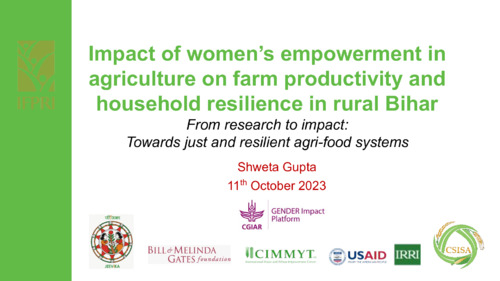Impact of women’s empowerment in agriculture on farm productivity and household resilience in rural Bihar
Abstract
Empowering women and reducing gender equality is widely recognized to contribute to agriculture growth, more civic engagement, lower economic deprivation, and better nutritional outcomes. We tested the relationship between women’s empowerment and household-level agriculture, nutrition and resilience outcomes, using a survey of 1,553 households in the eastern state of Bihar, India, drawn from the membership list of JEEViKA, a collection of women’s self-help groups. We administered the A-WEAI to both men and women within the same household to measure women’s empowerment and communitylevel gender parity. Our results showed that about 82% women and 83% men were found to be disempowered in the sample while only 6% households achieved gender parity. Empowered women were found to have better control over key household decisions such as expenditure on health, food, child education and investing surplus money. Moreover, empowered women were concentrated among historically disadvantages groups like lower castes and lower wealth quintiles, groups that have relatively egalitarian gender norms and higher participation of women in the workforce. However, such women were also found to be more food insecure than their disempowered counterparts, measured using food insecurity experience scale (FIES). More-empowered women were also less likely to report income loss and input shortages during COVID-19, have higher crop yield for non-wheat crops and reported better overall knowledge and adoption of farming practices. These results suggest women’s empowerment is crucial to achieve sustained agricultural productivity and food security and should be an important basis of poverty alleviation programs in agrarian economies.

